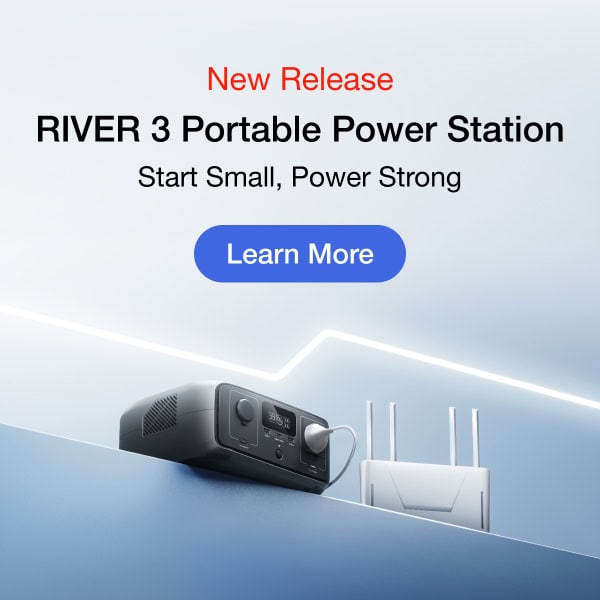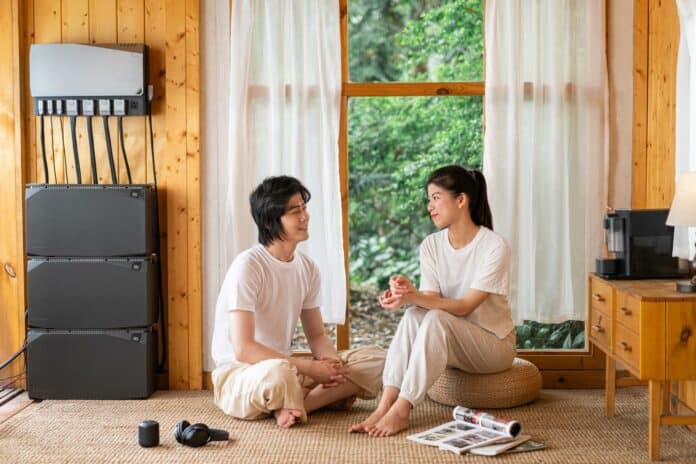Whether camping, fulltiming in a motorhome, fishing, or planning to live without being tethered to the electrical grid, you may be considering an off-grid power system.
Getting started with off-grid power doesn’t have to be complicated. While there’s some terminology to understand and a learning curve for the installation, this guide aims to simplify the process of setting up an off-grid power supply.
We’ll cover everything to know about off-grid systems, including their benefits, drawbacks, and the general installation process.
Let’s dive in!
What’s an Off-Grid Power System?
An off-grid power system takes an alternative electricity source like solar and converts it into usable electricity. The off-grid system isn’t tied to the local utility, meaning it can stand alone and won’t be affected by blackouts.
While solar is a popular choice for off-grid systems, you can use other forms of renewable energy or fossil fuel sources. The point is that you aren’t dependent on the grid.
There are many types of generators to choose from besides solar. Ultimately, you’ll have to pick the right fuel source and off-grid system that fits your needs.
Differences Between Off-Grid & On-Grid Power Systems
Off-grid systems aren’t connected to the utility grid and operate independently from your local utility company. Since they don’t connect to the grid, they require a power station, which converts the DC power captured by solar power to AC (household) electricity and acts as a giant battery to store solar energy.
On-grid solar power systems connect to the utility grid, meaning they don’t necessarily require batteries for storing power. Instead of batteries, they tap into the utility grid for electricity whenever the system isn’t producing enough electricity to meet your needs.
Let’s take a closer look at the significant differences between the two setups.
Access to Electricity
An off-grid power source doesn’t require access to the electrical grid, meaning it’ll only have power when the system generates electricity or is charged by an alternative source. For a solar-powered system, energy generation will come from solar panels, which convert sunlight into electricity.
Solar off-grid systems must use battery storage to store the excess electricity produced. When the sun isn’t out on cloudy days and nighttime, the system taps into the battery’s energy as the primary power source. EcoFlow solar generators can also store energy from AC outlets, car adapters, and even EV charging stations.
On-grid systems are connected to your local utility, meaning you’ll always have accessible electricity, other than during a blackout. You can enjoy electricity even when your solar system isn’t producing enough to meet your needs.
Excess Electricity Production Management
Off-grid systems need a way to store excess electricity, which usually takes the form of batteries. The reserved electricity powers your home, even when the weather is cloudy or at night.
Excess electricity produced by on-grid systems typically goes back to the grid. On-grid systems with a net meter allow the owner to receive credits for the excess electricity produced. These credits go towards paying for used electricity, allowing you to save on electricity bill costs. However, on-grid systems without a net meter often mean that the excess electricity generated won’t be available for you to tap into later.
Billing
Off-grid solar systems run on “free electricity” once the setup is installed and paid for. While they require a more significant upfront investment to cover the necessary equipment, they are more cost-effective and durable in the long term than fossil-fuel-powered generators. If you have to generate all your electricity from petrol or diesel, the price can vary dramatically, and you must constantly refuel.
On-grid systems must pay for any utility services they use. Typically, there’s a fixed charge for connecting to the grid and additional costs for the electricity you use minus any net meter credits.
Grid Power Outages
Off-grid systems are bulletproof against on-grid power outages. Since off-grid systems work independently, outages won’t affect your ability to generate electricity. Users of off-grid solutions can enjoy uninterrupted electricity even in extended blackouts, provided they can generate sufficient power for their needs.
On-grid systems depend on the grid’s utility — any power failure means disrupted access to electricity unless you have a home backup power system in place.
Benefits of Using an Off-Grid Power System
Off-grid power systems have many benefits, making them an attractive solution to campers, motorhomers, or people seeking energy independence.
Energy Independence
Off-grid power systems allow you to live anywhere with adequate resources to charge the equipment. It lets you live and work in remote areas and liberate yourself from being at the mercy of the local electrical company. You’re not affected when a power outage wreaks havoc on the community.
Reduced Carbon Footprint
Off-grid solar power systems help you to live a green lifestyle. Many off-grid energy sources, such as solar, water, and wind, are much more eco-friendly than on-grid and fossil fuel generators. These renewable energy sources don’t use fossil fuels, which reduces your carbon footprint.
Lower Energy Costs
Imagine living in a world without electric bills. With a renewable energy off-grid lifestyle, you’ll depend on virtually limitless, clean natural resources for energy production. Using battery storage, you won’t have to access the grid. With sufficient capacity, you can generate enough electricity to live off-grid on your own without having to contend with soaring electricity rates.
Quick Installation
The components of an off-grid solar system are relatively simple. Conversely, grid-tied systems are complex and involve labour costs to hire professionals for installation.
A system like the EcoFlow Power Kit is a plug-and-play system that combines multiple components into a single power hub. With fewer components, it saves space and the installation hassle.
Combining the EcoFlow Power Kits and Smart Generator will give you an all-in-one solution to support off-grid living and backup power. With dual fuel support, you can use petrol or (propane) LPG to maximise efficiency and give you multiple options for a fuel source if solar is unable to meet your needs.
Power kits allow different energy storage and output levels, with capacities ranging from 2kW to 15kW. That’s enough to power anything from a tiny home or motorhome to a full-sized house. With many charging methods available, it ensures you have electricity whenever you need it.

Drawbacks of Using an Off-Grid Power System
Off-grid power solutions also have some drawbacks. Make sure to weigh the benefits and drawbacks to see whether choosing off-grid power is worth it for your situation.
Higher Initial Upfront Investment
Alternative off-grid power solutions typically cost more upfront than on-grid energy. Depending on the power source — solar, wind, or water — the initial technology expenditure will certainly exceed traditional on-grid power.
If you’re choosing solar power for an off-grid lifestyle, it may take up to ten years to recoup the costs from savings on electricity bills alone.
However, off-grid power systems are more cost-effective in the long run. Over time, you’ll be racking up free electricity and solar tax credits, helping to offset the initial costs. Permanent solar power installations can also increase the value of your home.
Limited Energy Storage
No matter your energy source, you’ll have limited energy storage. A petrol or propane-fueled generator requires sufficient fuel supply at all times. A solar generator needs enough battery capacity to power your daily needs.
When storage is limited, there’s always a chance you can run out of power. However, some generators allow for battery expansion, such as the EcoFlow DELTA Pro solar generator. The EcoFlow DELTA Pro comes with a 3.6kWh capacity, with room to expand storage up to 25kWh, giving you complete energy dependence from the grid. You can also pair it with the Smart Generator (Dual Fuel) to provide you with a last line of defence when your power starts to run out.
It’s essential to calculate your power consumption needs and account for potential unforeseen situations when assessing your energy storage requirements.
Maintaining Energy Efficiency
Going off-grid means you’re responsible for maintaining your system. That means replacing the battery, solar panels, or other components that diminish in efficiency or deteriorate over time.
Fortunately, a unit like the EcoFlow DELTA Pro Generator features a high-tech LFP battery with 6,500 cycles. It’ll take years before it reaches 50% of its original storage capacity. As a result, you won’t have to worry about replacing the battery for over a decade.
If your off-grid system uses solar, you must maintain and clean your solar panels. EcoFlow Solar Panels are waterproof and dust-resistant, protecting them from losing energy efficiency over time. An additional ETFE film protects against ultraviolet light.
What Are the Costs of Using an Off-Grid Power System?
The costs can vary significantly depending on what energy source you use. It’s an enormous range, making it challenging to prepare a budget for your off-grid system.
The total cost varies depending on the fuel or power source and the size of your system — such as how much battery storage, output, and solar panels you need. There are also potential hidden costs like generator maintenance or battery replacement.
You might also need to pay for labour costs and installation, which adds to the total price.
As noted, your solar off-grid power system may be available for solar tax credits and other incentives that can dramatically offset the upfront costs.
Another option to reduce labour and installation costs is to set up your own off-grid power system, which we will get into next.
How to Set Up an Off-Grid Power System
We’ll cover the step-by-step guide on setting up a solar power system for this guide. While there are other options for off-grid power, solar power is the most popular.
Step 1: Consider Your Energy Requirements
Before purchasing your off-grid solar power setup, you’ll want to calculate your total required power consumption.
That means making a list of all your electrical appliances. For each appliance and device, determine how many watts they use and how many hours you plan to use them to get the total energy load in watt-hours.
An energy calculator can estimate your power consumption for various household appliances and the load required for an off-grid build.
Step 2: Select the Appropriate Solar Panels and Battery System
Based on your energy consumption requirements, choose the right off-grid power system with enough capacity to meet your needs.
Let’s say your total energy consumption needs are 10 kWh per day. You may consider a 15 kWh system to satisfy your daily requirements.
There are many factors you’ll need to consider when selecting your off-grid power system, such as:
- The size and number of solar panels
- Your storage capacity from your power station/power hub
- The size and type of charge controller
- The inverter rating
Step 3: Choose the Right Placement for Your Solar Panels
Choosing the proper placement for your solar panels is essential for maximising energy efficiency in your home. You want to avoid excessive shade and give your panels access to direct sunlight. Solar panels are most efficient when tilted toward the south and installed in sunny locations with no obstructions that could block sunlight.
You’ll also need to consider whether you’d like your panels installed on a roof. The rooftop installation prevents wind from knocking off your panels and keeps the placement consistent, letting you better plan your average daily energy production.
However, you can most mount the panels on the ground and have greater flexibility in moving the panels to wherever best maximises sunlight capture. A camper would choose a portable solar power solution, while a homeowner may prefer to have their panels mounted.
Step 4: Set Up Your Solar Battery Compartment
Every power station is unique in its setup. The EcoFlow Power Kit offers an all-one solution, making it easy to assemble and mount inside your off-grid home or motorhome. Here’s how to set up the EcoFlow Power Kit and battery compartments:
- Align the mounting bracket of your Power Hub according to where you plan on placing your batteries
- Place the Power Hub into the bracket until it locks, and screw the bottom mounting bracket.
- Pick a spot to place your batteries close to your Power Hub and stack them vertically or horizontally. Use the mounting clamp to secure the batteries in place.
- Connect each battery to the Power Hub before stacking them for easy setup. ‘
Step 5: Install the Smart Distribution Panel
A distribution panel is a component that monitors and controls your system’s power. Users can modify how their power gets distributed among the appliances. With EcoFlow power kits, users can manage this energy distribution from the panel or the EcoFlow app.
Step 6: Set Up Your Power Console and Connect Solar Panels to Power Console
The power console lets you control your entire power system. You can monitor energy usage, adjust settings and view your energy input from the screen. You’ll need to connect the power hub to the smart distribution panel and the power kit console using the RJ45 CAN cable, DC Main Out Cable, and AC Main Out Cable.
Conclusion
There are many practical use cases for an off-grid power solution, such as camping, living in your motorhome or tiny home, or simply home backup power storage. Off-grid solar systems give you the energy independence you need to live off-grid.
Now that you know all about the benefits, drawbacks, costs, and installation requirements of off-grid power systems, you’re now informed to make the call for yourself whether they’re the right solution for your home.





